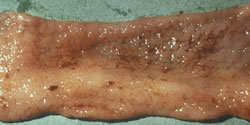| Paratuberculosis Johne's Disease |
Paratuberculosis is a chronic mycobacterial disease characterized by irreversible wasting, diarrhea and death from cachexia in ruminants. Etiology Paratuberculosis results from infection by Mycobacterium avium subsp. paratuber-culosis, an acid-fast rod previously known as Mycobacterium paratuberculosis and M. johnei. Transmission In ruminants, M. avium subsp. paratuberculosis is mainly transmitted by the fecal–oral route. Infected animals can shed large numbers of organisms in the feces; this shedding can begin before the onset of clinical signs. Asymptomatic carriers may shed the bacteria intermittently. M. avium subsp. paratuberculosis has also been isolated from colostrum, milk, udder, and the male and female reproductive tracts. Transmission can occur on fomites, and insects may act as mechanical vectors. Clinical Signs In cattle, the main symptoms of paratuberculosis are diarrhea and wasting. Most cases are seen in 2 to 6 year old animals. The initial symptoms can be subtle and may be limited to weight loss, decreased milk production or rough-ening of the hair coat. The diarrhea is usually thick, without blood, mucus or epithelial debris, and may be intermittent at first. The temperature and appetite are usually normal and animals are alert. Paratuberculosis is progressive; affected animals become increasingly emaciated and usually die as the result of dehydration and severe cachexia. Treatment There is no satisfactory treatment for paratuberculosis. Theoretically, some combinations of antibiotics might be successful; however, long-term treatment would probably be required and it is not likely to be economically feasible. |
References:
|



